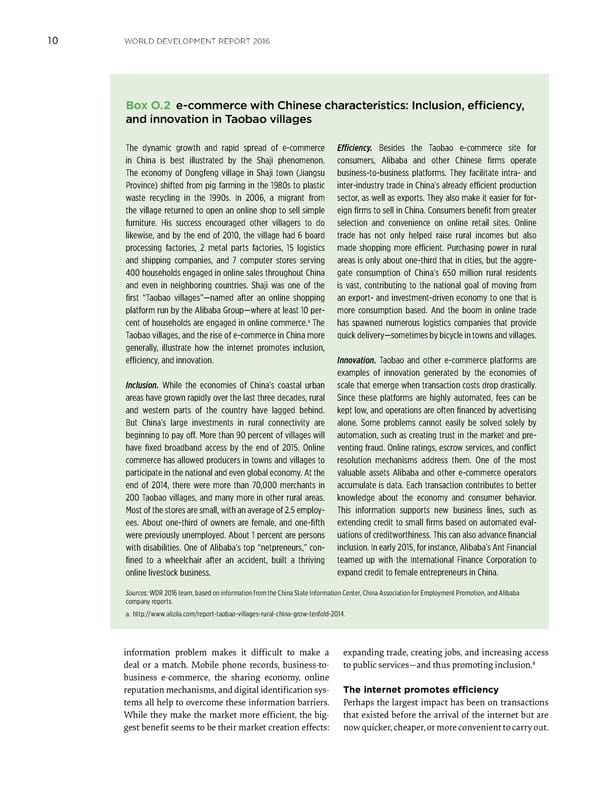WORLD DEVELOPMENT REPORT 2016 10 Box O.2 e-commerce with Chinese characteristics: Inclusion, efficiency, and innovation in Taobao villages The dynamic growth and rapid spread of e-commerce Efficiency. Besides the Taobao e-commerce site for in China is best illustrated by the Shaji phenomenon. consumers, Alibaba and other Chinese firms operate The economy of Dongfeng village in Shaji town (Jiangsu business-to-business platforms. They facilitate intra- and Province) shifted from pig farming in the 1980s to plastic inter-industry trade in China’s already efficient production waste recycling in the 1990s. In 2006, a migrant from sector, as well as exports. They also make it easier for for- the village returned to open an online shop to sell simple eign firms to sell in China. Consumers benefit from greater furniture. His success encouraged other villagers to do selection and convenience on online retail sites. Online likewise, and by the end of 2010, the village had 6 board trade has not only helped raise rural incomes but also processing factories, 2 metal parts factories, 15 logistics made shopping more efficient. Purchasing power in rural and shipping companies, and 7 computer stores serving areas is only about one-third that in cities, but the aggre- 400 households engaged in online sales throughout China gate consumption of China’s 650 million rural residents and even in neighboring countries. Shaji was one of the is vast, contributing to the national goal of moving from first “Taobao villages”—named after an online shopping an export- and investment-driven economy to one that is platform run by the Alibaba Group—where at least 10 per- more consumption based. And the boom in online trade cent of households are engaged in online commerce.a The has spawned numerous logistics companies that provide Taobao villages, and the rise of e-commerce in China more quick delivery—sometimes by bicycle in towns and villages. generally, illustrate how the internet promotes inclusion, efficiency, and innovation. Innovation. Taobao and other e-commerce platforms are examples of innovation generated by the economies of Inclusion. While the economies of China’s coastal urban scale that emerge when transaction costs drop drastically. areas have grown rapidly over the last three decades, rural Since these platforms are highly automated, fees can be and western parts of the country have lagged behind. kept low, and operations are often financed by advertising But China’s large investments in rural connectivity are alone. Some problems cannot easily be solved solely by beginning to pay off. More than 90 percent of villages will automation, such as creating trust in the market and pre- have fixed broadband access by the end of 2015. Online venting fraud. Online ratings, escrow services, and conflict commerce has allowed producers in towns and villages to resolution mechanisms address them. One of the most participate in the national and even global economy. At the valuable assets Alibaba and other e-commerce operators end of 2014, there were more than 70,000 merchants in accumulate is data. Each transaction contributes to better 200 Taobao villages, and many more in other rural areas. knowledge about the economy and consumer behavior. Most of the stores are small, with an average of 2.5 employ- This information supports new business lines, such as ees. About one-third of owners are female, and one-fifth extending credit to small firms based on automated eval- were previously unemployed. About 1 percent are persons uations of creditworthiness. This can also advance financial with disabilities. One of Alibaba’s top “netpreneurs,” con- inclusion. In early 2015, for instance, Alibaba’s Ant Financial fined to a wheelchair after an accident, built a thriving teamed up with the International Finance Corporation to online livestock business. expand credit to female entrepreneurs in China. Sources: WDR 2016 team, based on information from the China State Information Center, China Association for Employment Promotion, and Alibaba company reports. a. http://www.alizila.com/report-taobao-villages-rural-china-grow-tenfold-2014. information problem makes it difficult to make a expanding trade, creating jobs, and increasing access deal or a match. Mobile phone records, business-to- 8 to public services—and thus promoting inclusion. business e-commerce, the sharing economy, online reputation mechanisms, and digital identification sys- The internet promotes efficiency tems all help to overcome these information barriers. Perhaps the largest impact has been on transactions While they make the market more efficient, the big- that existed before the arrival of the internet but are gest benefit seems to be their market creation effects: now quicker, cheaper, or more convenient to carry out.
 World Development Report 2016 Page 21 Page 23
World Development Report 2016 Page 21 Page 23